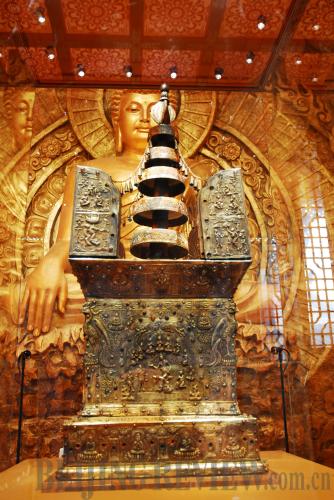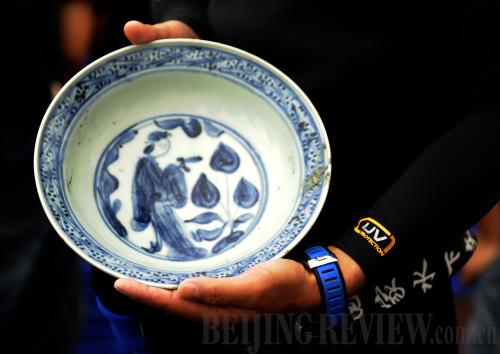|
The Dabaoen Temple Site in Nanjing, Jiangsu Province
 |
|
HOLY SHRINE: A stupa-shaped reliquary is found in 2008 at the Dabaoen Temple Site in Nanjing, Jiangsu Province (XINHUA) |
The site is home to a number of temples, including the Changgan Temple of the Northern Song Dynasty (960-1127) and the Dabaoen Temple of the Ming Dynasty (1368-1644). Excavation of the Dabaoen Temple began in February 2007 and was concluded in November 2010.
In November 2008, archeologists unearthed a stupa-shaped reliquary, which was believed to be one of the 84,000 shrines made during the reign of King Ayu of India (273-236 B.C.), in which the remains of Sakyamuni, called shelizi in Chinese, were enshrined.
The Sunken Ship Nan'ao 1 in Shantou, Guangdong Province
 |
|
UNDERWATER FINDING: An archaeologist shows a piece of porcelain found from the sunken ship Nan'ao 1 on June 12, 2010 (XINHUA) |
The Nan'ao 1, which is about 27 meters in length and 7.5 meters at its largest width, consists of at least 15 storage cabins. More than 11,000 artifacts had been found during underwater excavations, including more than 10,000 pieces of porcelain, about 100 metal objects and 150 strings of coins. The body material, ware color, shape, blue and white designs and firing technique of the porcelain found in the ship show the characteristics of porcelain produced during the reigns of emperors Jiajing (1522-1566) and Wanli (1573-1620) of the Ming Dynasty (1368-1644). Archaeologists said these porcelain might come from private kilns in southeast China, including the Jingdezhen kilns in Jiangxi, the Zhangzhou kilns in Fujian, and the Dapu kilns and Raoping kilns in Guangdong.
In addition to the value of its cargo, the archaeological excavation was undertaken under 24 meters of water, setting up a model for future submarine archaeological work. |
